

Evil Eye Wadjet Bag
![]()
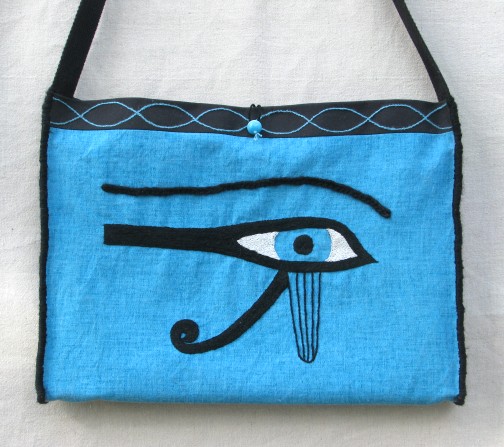
In ancient Sumerian texts we see records of an eye ailment they termed “igi-hulu”, the evil eye. We know this ailment as conjunctivitis or commonly called pink eye due to the membranes in the eye becoming inflamed and more red/pink. The “evil eye” can be caused by viral and bacterial infections, which are exacerbated by the brightness of a desert sun for these regions. If the infection gets worse, it can cause permanent eye damage or blindness. So the Sumerians found a medicinal application of simbi (sembi), known to us as kohl, to line their eyes for protection. This kohl mixture was made from charred frankincense resin which had anti-bacterial properties. By lining the eye with the kohl, not only were they fighting the bacteria, but the dark liner also helped to deflect the irritating brightness of the sun, much the way football players place dark smudges under their eye or the ever popular modern sunglasses protecting the eyes. Other cultures not having access to charred frankincense, used other compounds like antimony, which had lead in it. The lead acted as the anti-bacterial, though lead has it own poisonous problems.
What many may think was decorative or cosmetic, was actually medicinal. But as with so many things, the meaning behind the practice is lost and only the images remain. Many men and women line their eyes these days, but it is for decorative purposes, not to medicinally ward off the “evil eye.”
Eventually the association of the eye symbol came to hold a talisman effect in warding off evil. This was very common among the ancient Anatolian, Aegean Sea territories, south through the Levant, into northern Africa. It was common in the ancient Phoenician cultures that traded and dwelt in these territories, including the later Carthaginians, descendents of the Phoenicians, that settled in north Africa. The ancient Phoenicians were believed with their glass techniques to be the originators of the blue/green evil eye beads that are used to ward off evil. This practice stems from the pale blue green eyes of the protectress Athene whose reputation was that of protector of the peoples, prior to being conquered by the Hellenistic Indo-Europeans who made her a chaste goddess to protect their warriors, removing her mother attributes over time. Pausanias, Description of Greece 3. 18. 2 (this may be a latter application to an older name and belief system) : "As you go towards what is called the Alpion [in Sparta] is a temple of Athena Ophthalmitis (Goddess of the Eye). They say that [the historical leader] Lykourgus dedicated it when one of his eyes had been struck out by Alkandros, because the laws he had made happened not to find favour with Alkandros. Having fled to this place he was saved by the Lakedaemonians from losing his remaining eye, and so he made this temple of Athena Ophthalmitis." Another title of Athene is Apotropaia – Averter of Evil.
Her myths state that she was part of a mother culture that included northern Africa, specifically Algeria, Lybia and Tunisia territories where the Imazighen (the Free People, known by the derogatory Roman designation of Berber, variant of barbarian) people live. In these cultures, Athene, also known by the later Carthaginian name of Tanit, is the same as the Egyptian Neith. In the Imazighen language female names begin with the Ta prefix and end in a T. Tanit is Ta-Neith. In the Egyptian culture, the eye of the protective mother goddess is called a wadjet or udjat. She was an early pre-dynastic goddess. Later this eye image was assimilated in the worship of Ra, associated with the sun. It is said that when the eye is the left eye, it is representative of the moon, the mother and the right eye is the eye of the sun, Ra.
In archaeology, these evil eyes are found in glass beads, in faience (tin glazed pottery), lapis lazuli (a blue stone), all of which have the common denominator of blue. They evil eye is also portrayed in textiles, again, with the same purpose of warding off evil.
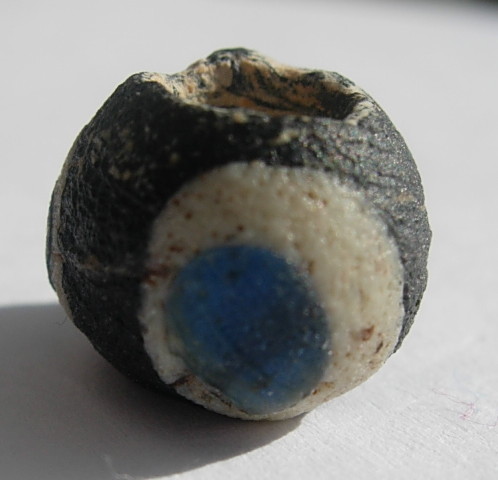

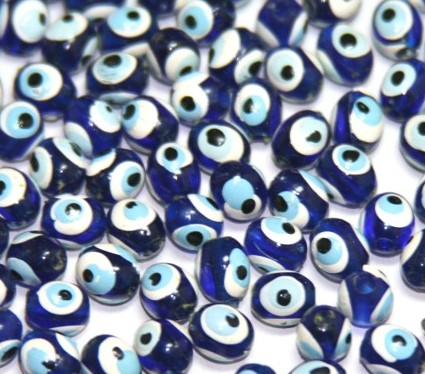
Phoenician evil eye beads from burials and modern glass beads.
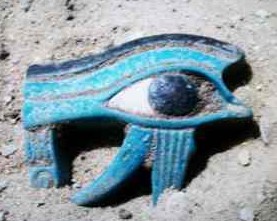
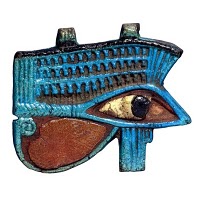
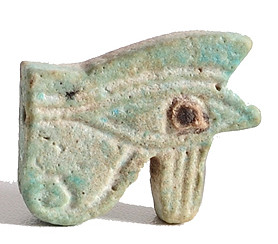
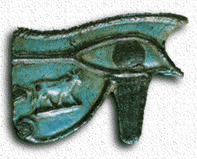
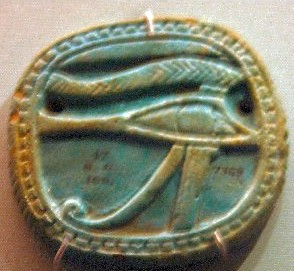
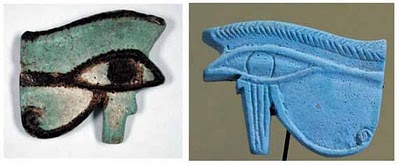
Wadjets from Egypt, the first row 1. 1200 BCE, 2. 1069 BCE, 3. 1000 BCE
You will notice that several have the braided eyebrow. Textile wise, this is a style from the Aegean Sea area, specifially Cretan embroidery, which was the oldest known form of the name Athene - Athana Potnija. It is possible that the harder artifacts are survivals of the ancient textiles that do not survive the ravages of time and weather.